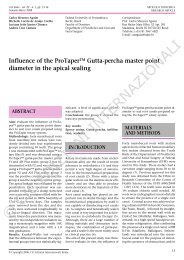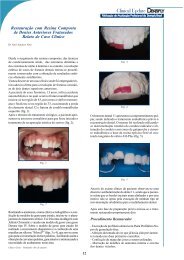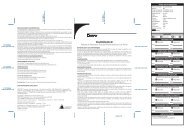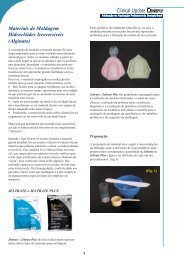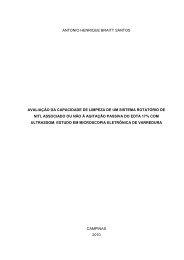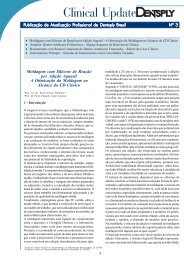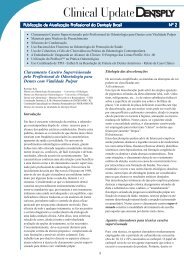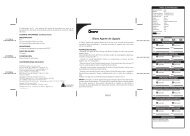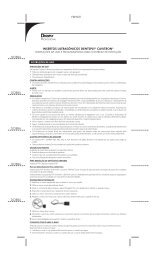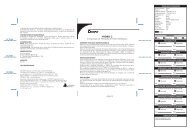Create successful ePaper yourself
Turn your PDF publications into a flip-book with our unique Google optimized e-Paper software.
Frankenberger et al<br />
Fig 1 Fractured μTBS specimen at the resin composite aspect<br />
with Syntac not separately cured. Short resin tags have been<br />
pulled out of the dentin at the cavity floor.<br />
Fig 2 Fractured μTBS specimen with XP Bond + SCA at the<br />
dentin side. The interface is ruptured at the bottom of the hybrid<br />
layer at the transition to the funnel-shaped orifices of dentinal<br />
tubules.<br />
RESULTS<br />
The results of the study are displayed in Table 2. Contamination<br />
with temporary cement reduced dentin bond<br />
strengths (p < 0.05). Removing remnants of cements with<br />
Prophypearls air-polishing significantly decreased dentin<br />
bond strengths (p < 0.05). Separate light curing of the adhesives<br />
did not produce higher dentin bond strengths (p ><br />
0.05). The dual-cured adhesive exhibited significantly higher<br />
bond strengths in control groups without IDS (p < 0.05).<br />
Immediate dentin sealing (resin coating) prior to temporizing<br />
increased internal bond strength for all adhesives under investigation<br />
(p < 0.05). Fractographic analysis exhibited insufficient<br />
interface formation when light-cured adhesives<br />
were cured together with the luting resin composite (Fig 1).<br />
Fractured interfaces of XP Bond showed characteristic positive<br />
features of typical etch-and-rinse adhesives (Fig 2).<br />
DISCUSSION<br />
The survival of ceramic inlays is fundamentally dependent<br />
on durable enamel bonding; also when the dentin aspects<br />
were covered with a cement lining, long-term success was reported<br />
to be good. 4,14-16 However, the present study exclusively<br />
focussed on internal dentin bond strength beneath adhesive<br />
inlays. Due to easier processing, direct resin composite<br />
inlays were chosen, because they reveal the same<br />
dentin-resin composite interface as ceramic inlays. 12,13,16,29<br />
Hikita et al 11 evaluated enamel and dentin bond<br />
strengths of luting systems for adhesive inlays. It was remarkable<br />
that Syntac and Variolink II without separate light<br />
curing of the adhesive obtained the lowest dentin bond<br />
strengths in that investigation. This may be surprising, because<br />
especially this combination of light-curing adhesive<br />
and dual-curing luting resin composite has been repeatedly<br />
reported to be clinically effective. 4,14,15 This clearly demonstrates<br />
that the clinical success of ceramic inlays as well as<br />
of direct resin composite restorations may be primarily dependent<br />
on good and durable marginal adaptation to enamel.<br />
The present results also clearly confirm the theory that<br />
solely light-cured adhesives do not receive enough light energy<br />
through 3-mm-thick adhesive inlays, not even under laboratory<br />
conditions. To elucidate the problem of insufficient<br />
light curing through ceramic inlays as demonstrated in vitro,<br />
marginal quality assessment alone is not sufficient. A previous<br />
and often cited study with conical ceramic inserts luted<br />
into standardized dentin cavities showed good bond<br />
strengths and marginal adaptation in vitro, even when the<br />
light-curing adhesive was not light cured separately. 5 However,<br />
in the course of push-out investigations, in most of the<br />
cases, enough light energy passes through the specimens,<br />
being considerably thinner than inlay cavities. Previous results<br />
showed that enough light intensity was always transported<br />
to the marginal areas of the luted ceramic inays,<br />
even in proximal margins below the CEJ. 1 Nevertheless, this<br />
does not necessarily mean that the light-curing adhesives<br />
under investigation revealed a complete cure in all areas beneath<br />
the ceramic inlays. The present results clearly show<br />
that results of marginal analyses may produce results which<br />
are not representative for what is happening deeper inside<br />
the restored tooth.<br />
In this context, it has often been discussed in the past<br />
whether a light-cured adhesive has to be separately light<br />
cured prior to the application of a luting resin composite.<br />
This study indicates that a separate light-curing step of lightcured<br />
adhesives was not beneficial for dentin bond strength.<br />
This may be attributed to the fact that heavily air-thinned layers<br />
of bonding agents are subjected to severe oxygen inhibition<br />
and are therefore almost not cured despite the presence<br />
of light energy for 40 s. Finally, due to reasons of contamination<br />
and oxygen inhibition, immediate dentin sealing<br />
272 The Journal of Adhesive Dentistry



